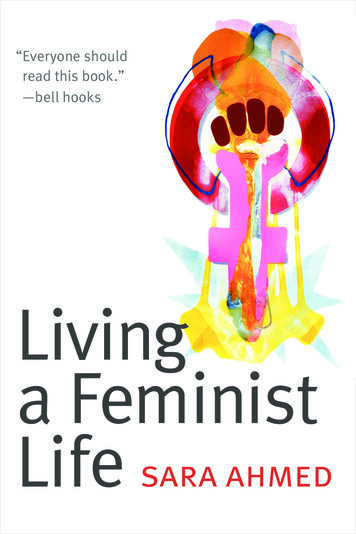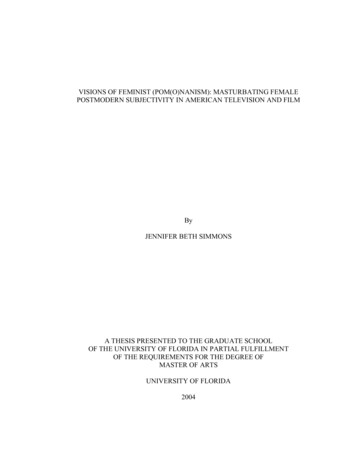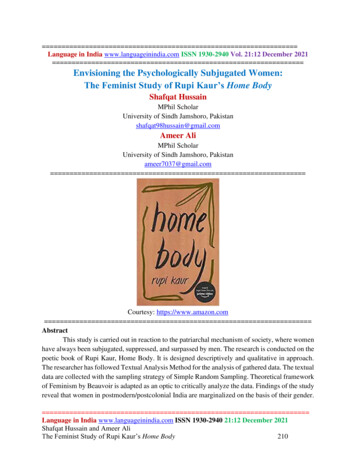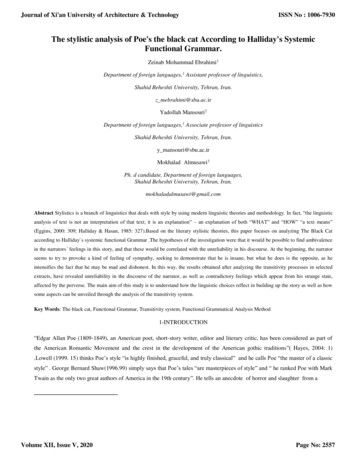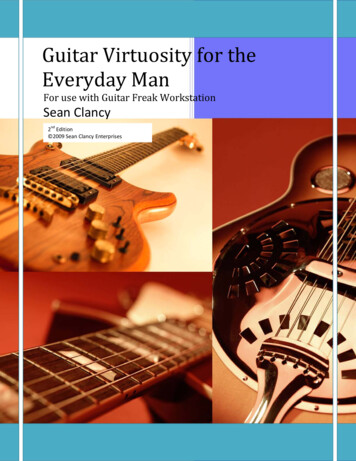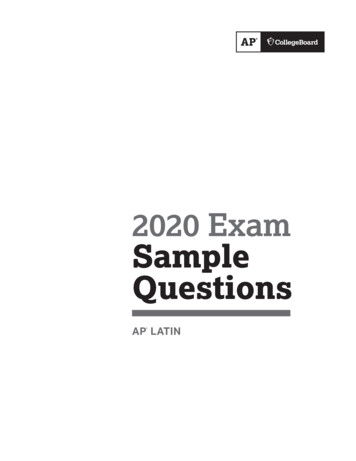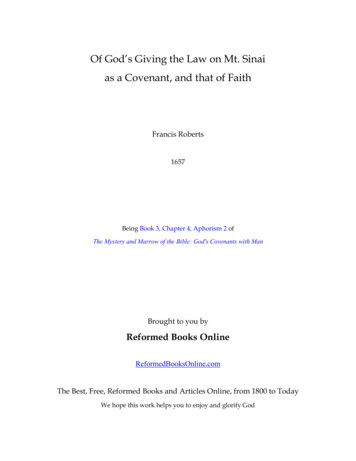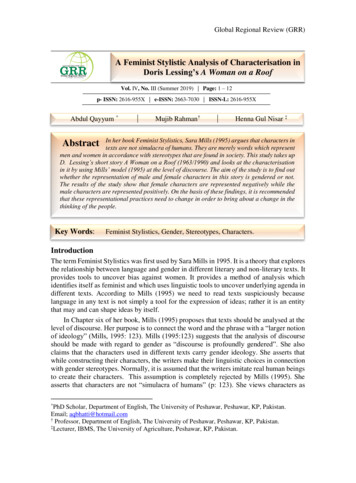
Transcription
Global Regional Review (GRR)A Feminist Stylistic Analysis of Characterisation inDoris Lessing’s A Woman on a RoofVol. IV, No. III (Summer 2019) Page: 1 ‒ 12p- ISSN: 2616-955X e-ISSN: 2663-7030 ISSN-L: 2616-955XAbdul Qayyum *Mujib Rahman†Henna Gul Nisar ‡In her book Feminist Stylistics, Sara Mills (1995) argues that characters intexts are not simulacra of humans. They are merely words which representmen and women in accordance with stereotypes that are found in society. This study takes upD. Lessing’s short story A Woman on a Roof (1963/1990) and looks at the characterisationin it by using Mills’ model (1995) at the level of discourse. The aim of the study is to find outwhether the representation of male and female characters in this story is gendered or not.The results of the study show that female characters are represented negatively while themale characters are represented positively. On the basis of these findings, it is recommendedthat these representational practices need to change in order to bring about a change in thethinking of the people.AbstractKey Words:Feminist Stylistics, Gender, Stereotypes, Characters.IntroductionThe term Feminist Stylistics was first used by Sara Mills in 1995. It is a theory that exploresthe relationship between language and gender in different literary and non-literary texts. Itprovides tools to uncover bias against women. It provides a method of analysis whichidentifies itself as feminist and which uses linguistic tools to uncover underlying agenda indifferent texts. According to Mills (1995) we need to read texts suspiciously becauselanguage in any text is not simply a tool for the expression of ideas; rather it is an entitythat may and can shape ideas by itself.In Chapter six of her book, Mills (1995) proposes that texts should be analysed at thelevel of discourse. Her purpose is to connect the word and the phrase with a “larger notionof ideology” (Mills, 1995: 123). Mills (1995:123) suggests that the analysis of discourseshould be made with regard to gender as “discourse is profoundly gendered”. She alsoclaims that the characters used in different texts carry gender ideology. She asserts thatwhile constructing their characters, the writers make their linguistic choices in connectionwith gender stereotypes. Normally, it is assumed that the writers imitate real human beingsto create their characters. This assumption is completely rejected by Mills (1995). Sheasserts that characters are not “simulacra of humans” (p: 123). She views characters as*PhDScholar, Department of English, The University of Peshawar, Peshawar, KP, Pakistan.Email; aqbhatti@hotmail.com† Professor, Department of English, The University of Peshawar, Peshawar, KP, Pakistan.‡Lecturer, IBMS, The University of Agriculture, Peshawar, KP, Pakistan.
Abdul Qayyum, Mujib Rehman and Henna Gul Nisarnothing more than words that are constructed and understood on the basis of differentstereotypes that exist about men and women in society. In this way, Mills (1995) finds thatcharacterisation, language, and gender are interconnected.In the modern world, our actions and thinking are greatly influenced by the charactersin different literary forms like poetry, drama, novel, and short fiction. Among these forms,the short story holds a prominent position. It is a very popular form today due to itsshortness. Any short story is based upon a few characters. These fictional and imaginedcharacters are constructed in such a way that readers start thinking that they are real; theystart identifying themselves with these characters. The readers want to act and behave likethe characters that they have read about. That is why it is extremely important to examinethese characters to discover if they carry gender ideology as claimed by Mills (1995).Feminist Stylistics provides us with such tools that could uncover the hidden bias incharacterisation. This study analyses different characters in A Woman on a Roof(1963/1990), a short story by Doris Lessing, from the perspective of feminist stylistics. Itaims to discover whether or not the characterisation in the story is gendered, whether ornot the characterisation is informed by stereotypical knowledge about men and women,whether or not there is any bias involved in the production of male and female characters.It also attempts to learn about the representational practices used in short fiction.Literature ReviewThe relationship between language and gender is an interesting and important area forresearchers today. Initially, the researchers worked on the distinguishing traits of women’sspeech and writing (Coates, 1996; Flynn, 1988; Lakoff, 1975; Rubin & Greene, 1992;Tannen, 1990; Taylor, 1978; West, 1984). However, in recent years, the research on thedistinguishing traits of women’s language has given way to research on the language usedto describe women. Now, researchers are more interested in exploring the representationof women in different texts. Siddiqui (2014: 88-97) collects a number of jokes whichrepresent women negatively. There are too many jokes about wives in which wives arepresented as boring, talkative, irrational, petty, curious and troublesome. Similarly, thereare other jokes which make fun of mother-in-law, presenting her as a prying and cruelcreature. Contrastingly, men are given the positive attributes of innocence, wisdom, andhelplessness.Research also shows that women are presented negatively in children’s books as well.Frawley (2008) took a bunch of students and asked them to listen to an audiotape of twoCaldecott Award-winning books. After some time all the children were required toreproduce what they had listened. Frawley (2008) found that the students distorted the storyto fit into their gender schema. It is clearly shown that children have the dangeroustendency of misinterpreting and distorting characters in children’s stories so that theyconform to their conventional gender schema.Another domain where women have been represented negatively is that of fairy-tales.Siddiqui (2014) shows that in a number of fairy tales, women are completely absent.Siddiqui (2014) links this fictitious exclusion of females with the literal exclusion offemales in real life. Siddiqui (2014) also claims that the male characters are representedpositively; they are presented as powerful, agile and dominant. However, female charactersare described as sentimental, weak, irksome, and wicked. Similarly, women are associatedwith unprofitable professions like making brooms and baskets and spinning wheels. AllPage 2Global Regional Review (GRR)
A Feminist Stylistic Analysis of Characterisation in Doris Lessing’s A Woman on a Roofthe profitable professions are controlled by men. Similarly, males are the saviours whilefemales are saved. Not only that, the hero saves a girl and marries her as a reward for hisbravery.Print and electronic media are very important elements of today’s world. Mediaactively participate in the construction and perpetuation of gender stereotypes. Accordingto Renzetti and Curran (2002: 146), a quick glance at the print news media can tell you thatthis is a patriarchal world in which we live. They hold that the feminine activities are nottreated as news; women are placed at a secondary section of the paper. Similarly, cosmeticadvertisements present women in negative colours. Wykes and Gunter (2005) observe thatin the early 20th century, the advertisers propagated the ideal image of a woman; thusordinary women were made to realise that they were imperfect. The solution for thisimperfection was to use a particular product. In this way, Wykes and Gunter (2005: 43)assert, women “were asked to buy themselves”.With the advent of Mills’ Feminist Stylistics in 1995, many researchers started usingit as a tool to investigate the representation of women in different texts. Ruth Page (2010)looks at the potential of feminist stylistics for exploring gender politics which works indifferent online texts. The online text which she selects for her study is a sex blog by ZoeMargolis. According to Page (2010), the author of the blog claims a feminist stance for herwork, but deep scrutiny of the language which is used for sexual experience suggests thatthis feminist stance has its limitations. The woman is presented as “the acted uponparticipant” by the verbs which Margolis uses for sex acts (p. 81). Similarly, Margolis’discourse of feminist deliverance is very limited; it fails to handle many oppressive sexualpractices which are used in the real world (p. 81). Through this analysis, Page (2010)demonstrates that feminist stylistics is very useful as a tool to analyse different texts (p.81).Ufot (2012) highlights the importance and timelessness of feminist stylistics byanalysing two novels: Pride and Prejudice (1813/1981) by Jane Austin and The General’sWife (1991) by Hume-Sotomi. According to Ufot (2012) feminist stylistics uses theconcepts of literary and linguistic theories to provide a feminist interrogation of texts. It isa systemic method for the analysis of a text which uncovers issues of sexism through theexamination of words, sentences, and discourse. It brings forth the relationship betweenlinguistic patterns and power, especially the way language is used for the dominationwomen in texts. Ufot’s (2012) study shows that both novels use feminist lexicogrammatical tropes to highlight the rejection of male stereotypes. By doing so, theyhighlight the continuity and timelessness of feminist stylistics as these works were writtenin two different ages.Another application of feminist stylistics on the genre of the novel comes from SaraKhazai, Beyad, and Sabbagh (2016). They make a feminist stylistic analysis of discourseand power relations in Gaskel’s North and South (1854/2012) by using speech act theory.The study shows that “despite the period’s very strict codes of conduct and etiquettegoverning women’s behaviour and interactions with the opposite sex, they neverthelessfound ways and means of manipulating language to control situations in an intelligentfashion and maintain power” (p. 7). The analysis of the conversational interactions betweenthe main characters of the novel reveals that “the female character actually creates anopacity of link between discourse and ideology, thus empowering herself and naturalizingher ideology for the male to make it seem common-sense” (p. 9).Vol. IV, No. III (Summer 2019)Page 3
Abdul Qayyum, Mujib Rehman and Henna Gul NisarArikan (2016) uses feminist stylistics to analyse fairy tales. She chooses AngelaCarter’s The Bloody Chamber (1981) for her study. It is a collection of rewritten fairy taleswhich are based upon traditional ones. The analysis is made at three different levels, asproposed by Mills (1995). Arikan (2016: 129) finds that in these stories Carter (1981)topples the age-old gender ideologies and stereotypes. Arikan (2016: 129) adds that Carter(1981) realises the power of language in producing sexism and deconstructs the sexistthemes in traditional fairy tales by providing alternative tales. Thus Carter (1981)constructs a new system in which females are powerful, brave, cruel and even evil”. Arikan(2016) concludes that both Mills (1995) and Carter (1981) have the same objective.Another interesting study in this regard is carried out by Nur Syuhada Mohd Radzi(2017). She looks at the relationship between cosmetic names and gender stereotypes byusing Mills’ (1995) model at the levels of word and clause. The study examines the wayadvertisers exploit language to represent women. Radzi (2017) finds that women aredescribed negatively in these names. The names of different cosmetics highlightstereotypical female traits and male dominance. According to Radzi (2017: 35), advertisersare “propagators of gender ideologies”. She believes that women will always be occupyinga secondary role in society if the advertising practices are not changed.In another research, Al-Nakeeb (2018) looks at the use of fragmentation in a Yemeninovel. The analysis makes use of both qualitative and quantitative approaches. The studyfinds that male and female bodies are equally fragmented in the novel. However, male andfemale characters are represented differently. Female characters are constructed withregard to their beauty and sexuality; contrarily, the male characters are presented with thehelp of their colour, physical deficiencies, skills, personality features, and their social andphysical power. In a similar study, Al-Nakeeb and Mufleh (2018) take up three Yemeninovels and look at the collocations and collocational networks of characters in these novels.They conclude that all the male characters along with one female character are cheerful,expressive and lively. However, most of the female characters are presented as victims;they are depicted as unimportant and dependent upon others.Asmat Sheikh, Fatima Ali, Nazia Suleman, Hira Ali and Hanvia Munir (2019)investigate the representation of women in Pakistani short fiction. By using Mills’ (1995)model of analysis, they find that male Pakistani writers are more sexist in their vocabularywhen they depict female characters. This sexism is evident in the naming practices: thenames of female characters are either derived from male names or they are based on thephysical features of females, like their beauty. The jokes used in the stories also showsexism. These jokes make fun of female bodies. The conversation between male charactersshows that females are considered to be “male property and their bodies are objects forverbal denigration” (p. 26). However, such sexism is not to be found in the stories pennedby female writers.MethodologyThe text selected for this research paper is A Woman on a Roof (Lessing, 1963/1990). Inher book, Feminist Stylistics, Mills (1995) proposes three different levels for analysingtexts: word, phrase/sentence, and discourse. In this research paper, the analysis is carriedout at the level of discourse only.The study uses the following toolkit extracted from Mills’ Feminist Stylistics (1995).Page 4Global Regional Review (GRR)
A Feminist Stylistic Analysis of Characterisation in Doris Lessing’s A Woman on a RoofGender RolesThe society expects men and women to perform different roles. That is why different textspresent women as housewives and men as workers. It is thought that women can only takecare of their husbands, wash dishes, clean the house, cook a meal and rear children. In case,they are shown as working women, they are given only insignificant jobs: teachers, officesecretaries, air hostesses, etc. All the profitable jobs are reserved for men.FragmentationFragmentation is a technique that is often employed in pornographic texts. The female islooked at not as a unified being but as a collection of different parts. The focus remains onher hips, legs, breasts, back, cheeks, lips, etc. Fragmentation is responsible for a number ofeffects. Firstly, the female character is depersonalised and action cannot be describedthrough her viewpoint. Thus the female experience is completely ignored. Another effectof fragmentation is that it arouses males’ sexual desires. So, the female is looked at as anobject for the satisfaction of males’ sexual desires.Description of Body PartsAccording to Mills (1995) in the case of male characters, the focus remains on their head,hair, and eyes. They are described in terms of their overall size. But the female charactersare portrayed, usually, through their lower body parts.Description of ClothingMills (1995) observes that clothes are used to produce a certain image in readers’ minds.For example, the leather jacket suggests strength and polished shoes evoke a sophisticatedpersonality (p. 125). Contrary to this, women’s clothing suggests sexuality, beauty andtenderness.CataloguingCataloguing refers to the fact that language provides numerous terms for the description ofwomen. For example, the words blonde, brunette, redhead and auburn are used to describewomen on the basis of their hair colour. These terms are not only used to depict a character,they are also used to connote sexual availability and beauty.Objectification/Sex ObjectsIn romantic literature, different parts of women’s bodies are compared with lifeless objects.Such a comparison with lifeless things depersonalises women; they assume thecharacteristics of these objects. They become inactive and inanimate like those objects withwhich they are compared. When they are objectified, they are thought to be an object forthe sexual gratification of men.PassivityIf we look at the actions which are performed by both male and female characters, we findthat females are presented as inactive while males are shown to be active, energetic andvibrant. Males are depicted as the doers and women as the recipient of actions performedby their male counterparts.Vol. IV, No. III (Summer 2019)Page 5
Abdul Qayyum, Mujib Rehman and Henna Gul NisarThe text of the story would be scrutinised closely, looking at the linguistic choicesmade by the writer in the construction of different characters because as discussed above,characters are nothing but words. The above-mentioned toolkit would be used to bring outthe representational practices used in the production of these characters.DiscussionThis section analyses the story, A Woman on a Roof (1963/1990), in accordance with themethodology described above.The first point which catches reader’s attention is the presentation of traditional genderroles in the story. All the female characters serve as typical housewives. It is their job to bewithin the house, performing household chores. There is no outside activity for them. Themain female character in the story, named as the women, does nothing except lying on theroof and tanning her body. She only smokes cigarettes and kills time by readingnewspapers. Another female character, Mrs Pritchett is also a housewife. She remainswithin her house and even does not want to go on the roof of her house. It is due to thisreason that Stanley appreciates her as he does not want any freedom or exposure forwomen. She provides shade to the three men by giving them a blanket. This shade orblanket is symbolic of relief which men expect from women. It is one of the typical rolesof women to provide relief to men working outside. Another nameless woman in the storyis managing her household. She is shown watering a yellow window box. In contrast, themale characters are out of their houses, working and earning for their families. They aresanitary workers. They are busy replacing guttering on the roofs. Another male character,Mrs Pritchett’s husband is airline pilot. Thus traditional gender roles are upheld in the story.The writer has used fragmentation for describing female characters in the story.However, the bodies of the three male characters are not that much fragmented; they arepresented as having whole bodies. There are very few references which the narrator makesabout the parts of male bodies. Thus, it is the male point of view that is presented in thestory. However, the body of the nameless heroine is completely fragmented; she isobjectified for the male eyes. All the parts of her body are foregrounded: eyes, thighs,breasts, buttocks, face, hands, chin, legs and arms. The parts of her body are mentionedforty-seven times. Thus, she is depersonalised and her point of view cannot be describedin the story.Connected with fragmentation is the issue of the description of body parts. Mills(1995) says that there is a difference in the description of the body parts of men and women;women’s legs and sexual organs are focused while men’s upper body is described. In thisstory, women are described through their lower and sexual parts; the focus is on their legs,breasts and back: “her breasts” (p. 110), “a flushed solid back” (p. 110), “the legs” (p. 111),“the women’s legs” (p. 112), “her hips” (p. 113), “her legs” (p. 112), “her back” (p. 113)“her buttocks” (p. 113), “Her legs” (p. 117), “her breasts” (p. 117), “her back, her thighsand her arms” (p. 118). But in case of men, it is their upper and front body which receivesall the attention: “the men in vests, with reddening shoulders” (p. 112), “His sun-heatedface” (p. 112), and “Stanley’s face was hard” (p. 113). One interesting point in this regardis that different parts of the heroine’s body are referred to as if they were persons inthemselves. They are detached from the woman’s personality. Look at the use of definitearticle instead of the possessive pronoun in the following example: “the legs did not move”(p. 111). Similarly, her back is also treated as a person: “he enquired of her glistening back”Page 6Global Regional Review (GRR)
A Feminist Stylistic Analysis of Characterisation in Doris Lessing’s A Woman on a Roof(p. 117). Thus it seems that the woman did not have legs but the legs had the woman. Itshows that men are interested in the parts of a woman’s body and not the woman herself.The description of clothing is a very important aspect of characterisation. It oftensupports the gender stereotypes which are prevalent in society. In this story, we find thatmen’s clothing shows their strength and elegance while women’s clothing highlights theirsexuality, casualness and beauty. The pieces of clothes which the woman is wearing arethose which satisfy men’s sexual desires. The first item that is mentioned is a scarf whichshe uses as a brazier (p. 110). This scarf is again mentioned more explicitly when thenarrator says that she “wore a red scarf tied around her breasts and brief red bikini pants”(p. 110). When her dressing is mentioned again, even the word pants diminishes into“scarlet triangle on her buttocks” (emphasis added; p. 113). Even when she is shown to bewearing clothes, she is wearing casual clothes, like a “white dressing gown” (emphasisadded; p. 113). When Tom imagines being with the woman, she is wearing “a black filmynegligée” (emphasis added; p. 114). Again the emphasis is on casualness and sexuality.The next reference to her dressing shows her in “white gown” (p. 114). Near the end of thestory, it is again a scarf that foregrounds her sexuality; this scarf has bound her breasts tightand “brown flesh bulged around it” (p. 117). The dressing of other female characters in thestory also focuses on their beauty or sexuality: the middle-aged nameless woman is wearinga “flowered summer dress” (p. 114). Similarly, the legs of the women sitting on the roofsare “stockingless” (p. 112). In contrast to women’s dressing, men’s dressing shows eithertheir formality or strength, but not beauty and sexuality. The men sitting in the sun arewearing “vests” (p. 112). They are again shown wearing “shirtsleeves or vests” (p. 114).Similarly, in the beginning, the three men are wearing “coats” (p. 110). They are wearing“thick socks and boots” (p. 110). As the story progresses, the reference is again made tothe boots of these three men: “their big boots” (p. 112). Use of the adjective big suggestsstrength. These men take off “their shirts and vests” to “expose their chests” (p. 114). Shirtsand vests suggest formality and strength. So, the difference is quite evident. In case ofwomen, the dressing evokes beauty, casualness and sexual desires while in case of men, itsuggests strength and formality.Connected with clothes is the idea of nakedness. The word naked is used again andagain for the woman: “stark naked” (p. 110), “nearly naked woman” (p. 111), “naked” (p.111), “all naked” (p. 113), “nearly-naked woman” (p. 117). Thus, the word naked is usedfive times for the woman. The point here is that this word is never used for men. Evenwhen they take off their shirts and vests, they are not called naked or nearly naked, unlikethe woman; they are said to have “exposed their chests” only (p. 114). Thus, when themales take off their clothes, the word expose is used for them but for females the word isnaked. It seems that clothes are more important for women than for men; the absence ofclothes is nakedness for women but not for men; thus nakedness relates only to women,they can be naked or nearly naked but men are never naked even when they are not wearingclothes.Cataloguing has also been used in the story. Women are described through their bodycolour and hair colour. The elaborate use of colour for women contrasts with the lack ofcolour for men. The nameless woman is described in the beginning as having “black hair”(p. 110). The colour of her hair is mentioned again at two occasions: “her black hair” (p.117), “her black hair” (p. 118). Although the word Brunette is not used explicitly by thewriter, the focus on the blackness of hair suggests the same word. In contrast to this woman,Vol. IV, No. III (Summer 2019)Page 7
Abdul Qayyum, Mujib Rehman and Henna Gul NisarMrs Pritchett is described as “a smart blond” (p. 115). Thus the two women aredistinguished on the basis of their hair colour. Another way of cataloguing women isthrough the colour of their skin. Again, we see that the narrator uses different colours todescribe the skin of the female characters: “she was white, flushing red” (p. 110), the mencould see “two pink legs” (p. 111), “a scarlet and white woman” (p. 111), “a brown woman”(p. 111), “healthy brown woman” (p. 112), “a brown woman” (p. 115), “her brownshoulders” (p. 116), “brown flesh” (p. 117), “Her legs were brown” (p. 117). Similarly, thewomen who had come to sun themselves had “scarlet legs” (p. 112). So, nine referencesare made to the colour of women’s bodies. In contrast, there is only one reference to thecolour of men’s body: “the men in vests with reddening shoulders” (p. 112). At other times,when colour is associated with men, it is to describe their emotions and not bodies: “Hefelt her unfairness pale him” (p. 117). It is evident that the use of colour highlights women’ssexuality. Men want to categorise women in terms of their body and hair colour; it suggeststhe sexual availability and attractiveness of women.Women are often thought to be consumable objects and not persons. It is clear in thenaming practices which are used in the story. All the men are referred to by using theirproper names: Stanley, Tom, Harry, Mathews. Only one woman is given a name, MrsPritchett. The heroine of the story does not receive any name from the writer. She is referredto as the woman. It is her sex which is used as her identity. That is how the males look atthe woman; for men, the most important thing about a woman is that she is a woman. Thislack of identity makes her an object, an object to be used by the eyes of men. Again thisobjectification of the female character results in her voicelessness- the story cannot befocalized from her perspective. The male characters are treated as humans and not asobjects and due to that reason, focalization keeps with them. That is why the narrator isomniscient and limited simultaneously; the omniscience of the narrator is in operationwhen it comes to the male characters; the narrator takes us into their minds and tells uswhat they are thinking and feeling. However, the inner world of the women is left withoutany comment. We do not know what is going on in their minds and hearts. Particularly, thenameless woman is presented from outside only, through what others think about her. Byexcluding female thoughts from the story, the narrator suggests that a woman has nothoughts; she does not have any other aspect of her personality except how she looks like.She is only an inanimate object to be looked at and either appreciated or depreciated. Thatis why the major characters in the story are either the lookers at or the looked at. Quiteobviously, Lookers at are male characters while the looked at is a female character. Thus,the female body is used as an object for male gaze.Although all three men look at the woman as an object to be controlled or to be had, itis Tom, the youngest in age, who looks at the woman as a sex object. When he looks at thehalf-naked woman, he is “excited and grinning” (p. 110).The narrator says that Tom’s“mind was full of the nearly naked woman” (p. 111). It is her nakedness which he is after;he catches her when she is rolling down her pants (p. 111). She looks like “a poster, or amagazine cover” to him (p. 112). Here he objectifies the woman by comparing her withlifeless objects: a poster and a magazine cover. He wants to possess this object. He findsthat there is a huge crane at work behind the woman. He wants to pick the woman throughthat crane and drop her near him (p. 112). Thus, he wants to own her by sheer force, treatingher like an object to be picked. Last night, he had dreamt that he was treated tenderly byher. He starts hoping that he would be invited into her house. As she is a very preciousPage 8Global Regional Review (GRR)
A Feminist Stylistic Analysis of Characterisation in Doris Lessing’s A Woman on a Roofobject for him, so he does not want to share her with anyone else. He already startspossessing her as when he cannot find her on the roof, he feels that she “betrayed” him byher absence (p. 114). He had again imagined that he was invited into the woman’s houseand she had been kind to him (p. 113). When he comes to know she had hidden from them,he is delighted because he thinks that “she was more his when the other men couldn’t seeher” (p. 115). Having thus possessed her imaginatively, he starts thinking about possessingher sexually. So, as soon as he finds an opportunity, he approaches the woman. But he isdisappointed to know that the woman did not have any feelings for him. Now, panic setsupon him because he had daydreamt that “she had held him in her arms, stroked his hair,brought him where he sat, lordly, in her bed, a glass of some exhilarating liquor” (p. 115).From these images, it is quite obvious that he wants to use the woman for his sexualgratification. But when the woman refuses to be possessed, he starts hating her. (p. 11
females in real life. Siddiqui (2014) also claims that the male characters are represented positively; they are presented as powerful, agile and dominant. However, female characters are described as sentimental, weak, irksome, and wicked. Similarly, women are associated with unprofitable pr
